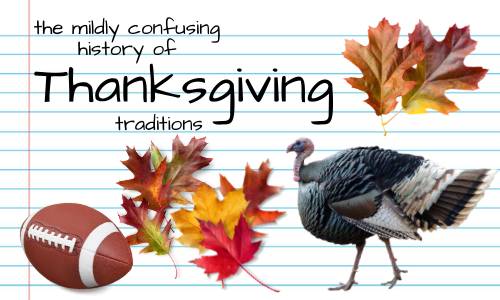Thanksgiving is possibly the most celebrated holiday in the United States. Since Pilgrims stepped old-timey foot onto America’s untapped soil and broke bread (and turkey) with Squanto and his pals, we have gathered in memory of the founding of our peaceful and benevolent nation by eating assorted side dishes and watching football, right? Well, it’s not quite that simple, but the origin of the holiday itself isn’t the only aspect of Thanksgiving with a complicated past. From the turkey iconography to the Macy’s Thanksgiving Day Parade, every Thanksgiving custom has some kind of layered backstory.
Turkey is the most commonly served dish for Thanksgiving dinner. According to the NTF (National Turkey Federation), 88% of Americans eat it on Thanksgiving day, but why? The classic account of the Pilgrims sitting down to eat with the natives of Wampanoag never makes any specific reference to turkey, only “fowl.” And yet, most families sit down and gobble a piece or two of the gobbling bird every year.
The reason turkey became such a popular holiday delicacy was likely a result of the bird’s abundance in 19th century America; and unlike hens and cattle, turkeys served no purpose to farmers other than as food. Collecting turkey eggs wasn’t common practice given how rarely turkeys lay eggs as compared to chickens, and birds don’t produce dairy products or other materials like cows or sheep. But to many families, turkey isn’t the most important dish of the holiday; other, more sentimental family foods take precedence over the classic avian entree.
“[In the past], we’d make a dish called bubble and squeak out of our Thanksgiving leftovers,” senior Aiden Vigus said. “It’s the leftover potatoes and other vegetables fried together… it’s amazing, I miss it dearly.”
Another Thanksgiving tradition with convoluted origins is the breaking of the wishbone, something many associate with Thanksgiving turkeys, but that actually has its roots in an ancient Italian custom. The Etruscan people, a civilization that occupied what is now eastern Italy, believed that the wishbone contained prophetic properties, not dissimilar from the way we use them now—making a wish and breaking the bone to grant it. It’s even said that the Romans, who interacted with the Etruscans, were the first to break the wishbones instead of stroking them like the Etruscans did.
Sitting down to watch the annual Thanksgiving football game is another Thanksgiving ritual that largely goes unquestioned. The tradition dates back to 1878, not long after the invention of the sport, when Yale and Princeton Colleges played the first recorded Thanksgiving game, which Yale won 2-0. But it wasn’t until the Detroit Lions hosted and subsequently lost a game against the Chicago Bears on Thanksgiving 1934 that it became a tradition for NFL teams to play on the holiday.
To the ire of many humbugs, Thanksgiving is often considered the beginning of the holiday season; the temperatures drop, the leaves turn brown, and bells start jingling. The transition to the winter season brings with it many cultural and religious celebrations. Hanukkah begins this year on Sunday, Nov. 28, the Mexican holiday Las Posadas begins on Dec. 16 and Christmas on Dec. 25.
“The day after Thanksgiving, [my family goes]to the Christmas tree farm,” History teacher David Orphal said. “And that’s the start of our Christmas season. I have nothing but good memories of that.”



